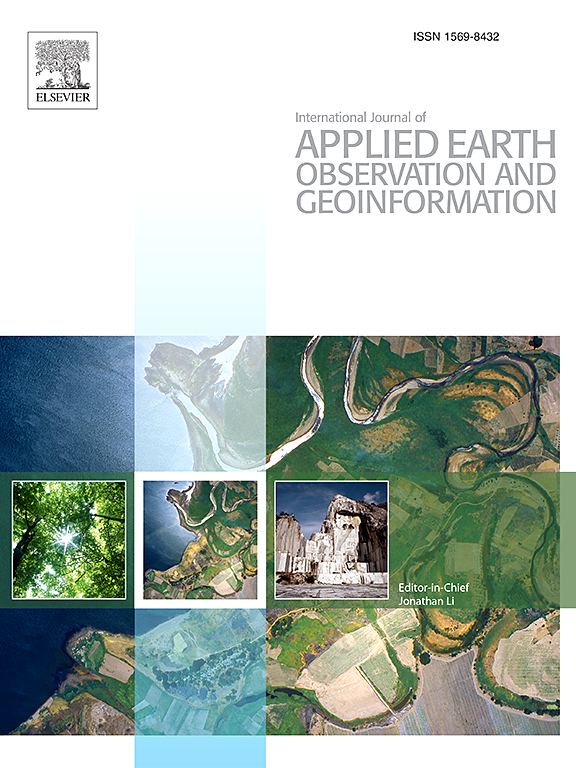Detection of Fall Armyworm infestation in maize fields during vegetative growth stages using temporal Sentinel-2
IF 7.6
Q1 REMOTE SENSING
International journal of applied earth observation and geoinformation : ITC journal
Pub Date : 2025-04-02
DOI:10.1016/j.jag.2025.104516
引用次数: 0
Abstract
Fall Armyworm (FAW), Spodoptera frugiperda (J.E. Smith) (Lepidoptera: Noctuidae), poses a significant risk to global food and income security by attacking various crops, particularly maize. Early detection and management of FAW infestation are crucial for mitigating its impact on crop yields. This study investigated the effect of FAW infestation on the spectral signature of maize fields and classified infestation severity in Bangladesh using Sentinel-2 satellite imagery and Random Forest (RF) classification. Field observations on FAW infestation severity (none, moderate, and severe), collected by the Bangladesh Department of Agricultural Extension during 2019 and 2020, were used to train the RF classifier. Six thousand nine hundred ninety-eight observations were collected from 579 maize fields through weekly scouting. The Kruskal-Wallis test and Dunn’s post-hoc test were applied to identify the most significant spectral bands (P < 0.05) for detecting FAW incidence and severity across different maize growth stages. The results demonstrated that the spectral reflectance from Sentinel-2 bands varied significantly among different classes of FAW infestation, with noticeable differences observed during the early developmental stages of maize (vegetative growth stages 3 to 8). RF identified nine spectral bands and two spectral vegetation indices as important for FAW infestation discrimination. The RF classifier was evaluated using five-fold cross-validation, achieving an overall accuracy between 74 % and 84 %. The independent test set’s accuracy ranged from 72 % to 82 %. The mean multiclass AUC ranged from 0.83 to 0.95. Moreover, the results demonstrated the feasibility of detecting the severity of FAW infestation using temporal Sentinel-2 data and machine learning techniques. These findings underscore the potential of remote sensing and machine learning techniques for effectively monitoring and managing crop pests. The study provides valuable insights for classifying FAW infestation using high-resolution multitemporal data.
利用Sentinel-2监测玉米田营养生长期秋粘虫侵染情况
秋粘虫(FAW),又称夜蛾(Spodoptera frugiperda, J.E. Smith)(鳞翅目:夜蛾科),通过攻击多种作物,特别是玉米,对全球粮食和收入安全构成重大威胁。早期发现和管理FAW虫害对减轻其对作物产量的影响至关重要。本研究利用Sentinel-2卫星图像和随机森林(RF)分类技术,研究了FAW侵染对孟加拉国玉米田光谱特征的影响,并对侵染严重程度进行了分类。利用孟加拉国农业推广部在2019年和2020年收集的FAW侵害严重程度(无、中度和严重)的现场观测数据来训练RF分类器。通过每周的侦察,从579块玉米地收集了69998个观察结果。应用Kruskal-Wallis检验和Dunn事后检验来确定最显著的光谱带(P <;0.05)用于检测不同玉米生育期FAW的发病率和严重程度。结果表明,Sentinel-2波段的光谱反射率在不同类型的FAW侵害中存在显著差异,在玉米发育早期(营养生长期3 ~ 8)存在显著差异。RF鉴定出9个光谱波段和2个光谱植被指数对FAW侵害判别具有重要意义。RF分类器使用五倍交叉验证进行评估,总体准确率在74%至84%之间。独立测试集的准确度在72%到82%之间。多类平均AUC范围为0.83 ~ 0.95。此外,研究结果还证明了利用Sentinel-2实时数据和机器学习技术检测FAW侵袭严重程度的可行性。这些发现强调了遥感和机器学习技术在有效监测和管理作物害虫方面的潜力。该研究为利用高分辨率多时相数据对一汽虫害进行分类提供了有价值的见解。
本文章由计算机程序翻译,如有差异,请以英文原文为准。
求助全文
约1分钟内获得全文
求助全文
来源期刊

International journal of applied earth observation and geoinformation : ITC journal
Global and Planetary Change, Management, Monitoring, Policy and Law, Earth-Surface Processes, Computers in Earth Sciences
CiteScore
12.00
自引率
0.00%
发文量
0
审稿时长
77 days
期刊介绍:
The International Journal of Applied Earth Observation and Geoinformation publishes original papers that utilize earth observation data for natural resource and environmental inventory and management. These data primarily originate from remote sensing platforms, including satellites and aircraft, supplemented by surface and subsurface measurements. Addressing natural resources such as forests, agricultural land, soils, and water, as well as environmental concerns like biodiversity, land degradation, and hazards, the journal explores conceptual and data-driven approaches. It covers geoinformation themes like capturing, databasing, visualization, interpretation, data quality, and spatial uncertainty.
 求助内容:
求助内容: 应助结果提醒方式:
应助结果提醒方式:


